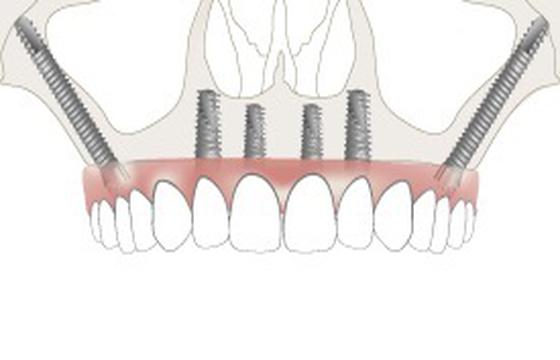
Private Nanodent Oral and Dental Health Center
- Akkuyu - Konyaaltı/Antalya
- 9 km from center
- 22 km to Airport
- Özel Nanodent Ağız Ve Diş Sağlığı Merkezi
Zygoma implants are considered a sophisticated treatment option that necessitates careful evaluation and planning by a dental practitioner educated in implant dentistry. They can provide significant benefits to patients who would otherwise have few options for improving their oral function and appearance. But why zygomatic and what are fifferences?

Zygoma implants are a type of dental implant used when standard implants cannot be placed due to insufficient bone volume in the jaw. They are primarily created for patients who have had substantial bone loss in the upper jaw, particularly around the maxillary sinuses.
First (one) visit, the dentist will evaluate the patient's oral health, taking X-rays, CT scans and checks for implants are a suitable option. Surgical Procedure(one or two days), zygoma implants is typically performed under local or general anesthesia. Then healing periods takes about three months.Final Prosthesis Placement,(one visit) teeth or dental restoration can be attached to the implants.
Zygoma implants, from the initial consultation to the placement of the final prosthesis, can take several months to complete.
Zygoma implants are commonly utilized in patients who have had considerable bone resorption in the upper jaw, which is often caused by long-term tooth loss or periodontal disease. By using the zygomatic bone as an anchor point, dental experts can offer patients a strong and solid solution for recovering their ability to eat, speak, and smile.
The process of getting zygoma implants normally consists of numerous stages and can vary based on the particular circumstances. Here's a summary of the timeline involved in the zygoma implant procedure,
First stage, the process begins with an initial consultation with a dental professional who is knowledgeable with implant dentistry. During this appointment, the dentist will check the patient's oral health, the degree of bone loss in the upper jaw, and whether zygoma implants are an appropriate option.
Treatment Planning, if zygoma implants are considered appropriate, the dentist will develop a treatment plan tailored to the patient's unique needs and objectives. This may include taking X-rays, CT scans, or other imaging studies to assess bone structure and plan implant placement.
Surgical Procedure, zygoma implants are normally placed under local or general anesthesia at a hospital or surgical center. The implants are anchored into the zygomatic bone via tiny incisions made in the gums. In some circumstances, additional bone grafting or augmentation surgeries may be required to enhance implant placement.
Healing Period, following implant placement, there is a healing period in which the implants fuse with the surrounding bone. This procedure, known as osseointegration, usually takes a few months. Temporary prosthetic teeth may be worn during this period to maintain both looks and function.
Final Prosthesis Placement, after the implants have fully integrated with the bone, the final prosthetic teeth or dental restorations can be placed to them. This may entail taking impressions and creating custom prostheses to achieve a precise fit and natural appearance.
The full zygoma implant procedure, from initial consultation to final prosthesis placement, might take several months. The exact timing will vary based on the patient's oral health, the intricacy of the case, and the need for further treatments like bone grafting. Patients should follow their dentist's suggestions and attend regular follow-up appointments.
There are several varieties of zygomatic implants, depending on their design and implantation technique. The primary types of zygomatic implants are,
Traditional Zygomatic Implants, these implants are lengthier than regular dental implants and are secured into the zygomatic bone, which is located in the cheek portion of the skull. These implants provide a strong basis for dental prostheses including bridges and dentures.
Quad Zygoma Technique, in the front region of the jaw, four zygomatic implants are placed alongside normal dental implants. This procedure supports a full arch of teeth in cases of severe upper jaw bone loss.
Extra-maxillary Zygomatic Implants, these implants are put outside the maxillary sinus and are utilized when there is insufficient bone in the maxillary sinus region. These implants are longer and reach beyond the sinus cavity, providing more support for dental prosthesis.
Zygomatic Implants with Pterygoid Implants, in some complicated circumstances, zygomatic implants may be combined with pterygoid implants for additional support. Pterygoid implants are inserted into the pterygoid bone, which lies behind the maxillary sinus. This combination enables for the insertion of lengthier prosthesis while also providing enhanced stability.
Each type of zygomatic implant has unique indications and concerns and the implant type chosen is determined by criteria such as the patient's anatomy, bone quality and the level of bone loss in the upper jaw. The dental professional determines the right implant type after doing a thorough evaluation of the patient's condition and treatment needs.
Zygomatic implants, like standard dental implants, are often constructed of biocompatible materials that are well tolerated by the body. The most often utilized materials for zygomatic implants are,
Titanium is the most common material for dental implants, including zygomatic implants. It has superior biocompatibility, robustness, and durability. Titanium implants fuse well with the surrounding bone via a process known as osseointegration, giving a solid foundation for dental prosthesis.
Titanium Alloys, some zygomatic implants are composed of titanium alloys, which blend titanium with additional metals such as aluminum and vanadium. Depending on the composition, these alloys can provide certain features such as greater strength or corrosion resistance.
Zirconia is a ceramic substance renowned for its biocompatibility and natural appearance. Zirconia implants are white, which may be beneficial for patients with thin or translucent gum tissue. However, zirconia implants may not integrate with the bone as well as titanium implants, therefore thus are not as commonly utilized in zygomatic implant surgeries.
Zygomatic implants are utilized when there is considerable bone loss in the upper jaw and standard dental implants are not an option. When zygomatic implants are not a possibility, there are other treatments available to restore upper jaw function and aesthetics. Some alternatives are,
Bone Grafting, when there is inadequate bone volume in the upper jaw, bone grafting operations can be used to supplement the existing bone. Bone grafts can be obtained from a variety of sources, including the patient's own body (autogenous bone transplant), donor bone (allograft), and synthetic materials (alloplastic graft).
Sinus Lift technique, also known as sinus augmentation, is a surgical technique that increases bone volume in the posterior maxilla (upper jaw) where the sinus cavity has extended into the area where dental implants will be inserted. During the treatment, the sinus membrane is raised and bone graft material is put beneath it to stimulate new bone formation.
Short dental implants are intended for circumstances in which there is limited vertical bone height in the jaw. These implants are shorter in length than standard implants and are ideal for patients with little bone volume. Short implants can be used with bone grafting procedures to support dental prosthesis.
Fixed or removable prostheses, including dental bridges or dentures, can be used to replace missing teeth when implant-supported restorations are not an option. These prosthetic devices can be supported by the remaining teeth, dental implants implanted in regions with sufficient bone support, or anatomical features such as the palate.
Orthognathic surgery is an option for severe jaw abnormalities or malocclusions that cannot be treated with dental implants alone. Orthognathic surgery repositions the upper or lower jaw to improve function, appearance, and bite alignment.



*The treatment pages provided on this platform are intended for informational purposes only and do not constitute medical or dental advice, diagnosis, or treatment recommendations. The information presented on these pages is not a substitute for professional medical or dental advice from qualified healthcare providers.
*By accessing and using the treatment pages on this platform, you acknowledge and agree to the terms of this disclaimer. If you do not agree with these terms, please refrain from using the treatment pages.